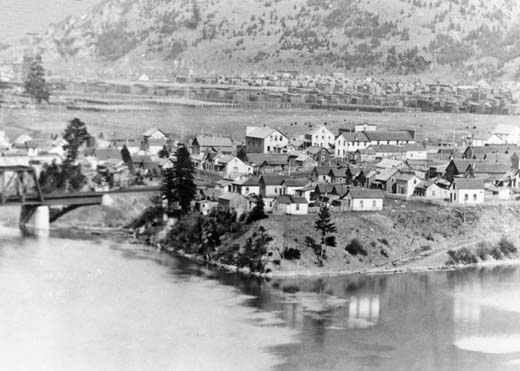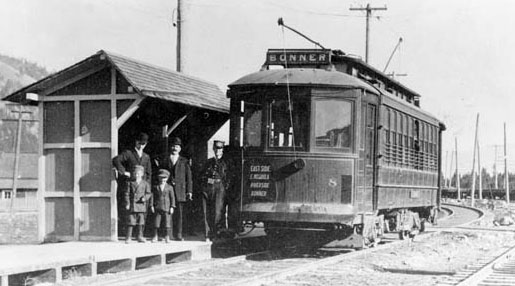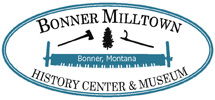 Milltown circa 1915 While residents of Bonner and Milltown were attracted to the area principally because of the economic opportunities offered by the mill, the settlements have very different origins. Bonner, the company town, was laid out and constructed by the mill management for the mill managers and supervisors.
Milltown circa 1915 While residents of Bonner and Milltown were attracted to the area principally because of the economic opportunities offered by the mill, the settlements have very different origins. Bonner, the company town, was laid out and constructed by the mill management for the mill managers and supervisors.
The land where the Riverside (later renamed Milltown) settlement sprang up is on a hill overlooking the confluence of the Clark Fork and Big Blackfoot rivers and about ½ mile south of the mill. Originally owned as farmland, John McCormick leased small parcels to workers. It was said that the mill workers built their homes by “moonlight” as the company did not seem to mind if inventory was diverted to building the small homes.
As the population grew, businesses sprang up to serve their needs. Longtime resident Mildred Dufresne reported that by 1892 there were already a dozen homes, a livery stable, a boarding-rooming house and three saloons.
In 1903, Riverside boomed. John McCormick sold his land to the Western Lumber Company owned by W.A. Clark. Part of the land and the newly purchased Ray farm would become the reservoir behind a proposed hydroelectric dam. More lots 35x130 feet were created and leased in the increasing worker population. It wasn’t until decades later that homeowners were able to purchase the land their homes are on.
The construction of the Milltown Dam beginning in 1905 and the arrival of the Western Lumber Company in 1910 brought more immigrants and most of the population of Riverside were of definite ethnic groups: Finns, the most numerous; Norwegians and Swedes; and French Canadians. In 1928 when the Anaconda Copper Mining Company purchased the Western Lumber Company, most workers stayed on to work for ACM.
Milltown has always been influenced by roads and railroad lines. Prior to 1908 when the reservoir was flooded, the Mullan Road was the main road with a ford at the mouth of the Blackfoot. Most of the businesses were located in the south side of town. By 1908 a new bridge was built across the Blackfoot at the site of the current pedestrian Black Bridge and businesses shifted their location to take advantage of the traffic. This road was used until 1948 when the present Highway 200 was constructed. In addition, the Northern Pacific ran through town east and west and for a time passengers and freight services were offered at the Milltown Station. Car 51 at the Milltown Stop The streetcar, powered by Clark’s dam, provided the main transportation between Bonner and Riverside to Missoula from 1910 to 1932. By then the first local stop was in Milltown; the name had been changed to Milltown in 1913 when it was learned that another post office already had the name of Riverside.
Car 51 at the Milltown Stop The streetcar, powered by Clark’s dam, provided the main transportation between Bonner and Riverside to Missoula from 1910 to 1932. By then the first local stop was in Milltown; the name had been changed to Milltown in 1913 when it was learned that another post office already had the name of Riverside.
